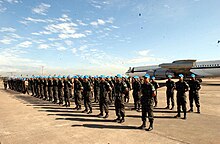United Nations Assistance Mission in East Timor
| UNMISET | |
|---|---|
| operation area | East Timor |
| German name | United Nations Assistance Mission in East Timor |
| English name | United Nations Mission of Support in East Timor |
| French name | Mission d'appui au Timor Oriental |
| Based on UN resolution | 1410 (May 17, 2002) |
| Other UN resolutions | 1543 (May 14, 2004) |
| Beginning | May 20, 2002 |
| The End | May 20, 2005 |
| management |
Kamalesh Sharma ( India ) Sukehiro Hasegawa ( Japan ) |
| Operating strength (min.) | 469 soldiers, 41 liaison officers, 135 police officers, 264 international and 523 local civilians (May 20, 2005) |
| Operating strength (max.) | 4,776 soldiers, 771 UN police officers, 465 internationals and 856 local civilians (August 31, 2002) |
| Deaths | 21st |
| costs | US $ 193.34 million |
| Location of the operational area |

|
The United Nations Mission of Support in East Timor shortly UNMISET (of English. United Nations Mission of Support in East Timor ) was the successor mission of UNTAET in with the aim of ensuring political stability of the young democracy of East Timor to achieve. For this purpose, the establishment of administrative structures, the implementation of legal regulations and the maintenance of public safety are planned. The basis is UN resolution 1410 of May 17, 2002. On May 14, 2004, resolution 1543 extended the mandate for a further year, which ended on May 20, 2005 with the handover to President Xanana Gusmão. Up until 2006, around 90 mostly civilian aid workers were active in the United Nations office in East Timor (UNOTIL) .
The Indian Kamalesh Sharma led the mission from May 2002 to May 2004. Then his previous deputy, the Japanese Sukehiro Hasegawa, took over. Military commanders were Lieutenant General Winai Phattiyakul ( Thailand , May 2002 to August 2002), Major General Huck Gim Tan ( Singapore , August 2002 to August 2003) and Lieutenant General Khairuddin Mat Yusof ( Malaysia , August 2003 to May 2005).
The Resolution 1410 allowed for a staff strength of 5,000 troops military personnel, including 120 military observers, 1,250 civilian police, 455 foreign civilian personnel, 100 civilian experts from the Support Group, 241 UN Volunteers and 977 local staff. Resolution 1543 named the upper limit of 477 military personnel, including 125 international reaction force and 42 liaison officers and 157 civilian police officers. Eleven UN soldiers, two military observers, two international and four local employees and two other people were killed in the operation, which cost US $ 565,497,900.
Soldiers and police came from Egypt , Argentina , Australia , Bangladesh , Benin , Bolivia , Bosnia and Herzegovina , Brazil , Bulgaria , Chile , China , Denmark , Fiji , Gambia , Ghana , Ireland , Japan, Jordan , Canada , Kenya , Croatia , Malaysia , Mozambique , Namibia , Nepal , New Zealand , Niger , Nigeria , Norway , Austria , Pakistan , Peru , Philippines , Portugal , Russia , Zambia , Samoa , Sweden , Senegal , Serbia and Montenegro , Zimbabwe , Singapore, Slovakia , Slovenia , Spain , Sri Lanka , South Korea , Thailand, Turkey , Ukraine , Uruguay , Vanuatu , the United Kingdom and the United States .
The main criticism of the subsequent mission was that it primarily served as logistical support for the remaining soldiers and less concerned with the training of specialists who are urgently needed.
See also
Individual evidence
- ↑ a b c UNMISET: Facts and Figures , accessed on February 6, 2018.

